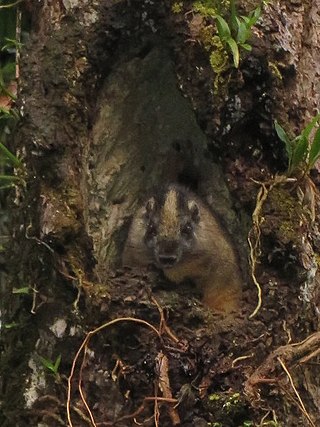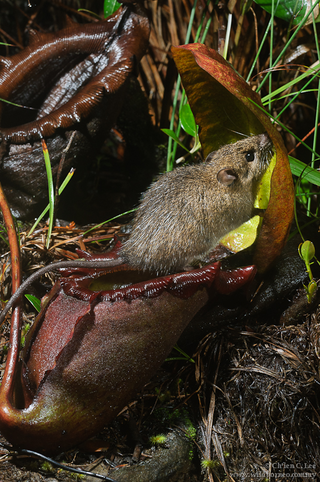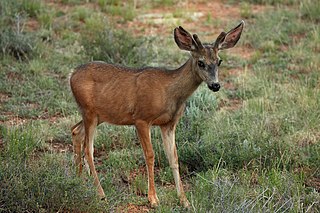
Procyonidae is a New World family of the order Carnivora. It includes the raccoons, ringtails, cacomistles, coatis, kinkajous, olingos, and olinguitos. Procyonids inhabit a wide range of environments and are generally omnivorous.

The genus Bassaricyon consists of small Neotropical procyonids, popularly known as olingos, cousins of the raccoon. They are native to the rainforests of Central and South America from Nicaragua to Peru. They are arboreal and nocturnal, and live at elevations from sea level to 2,750 m (9,020 ft). Olingos closely resemble another procyonid, the kinkajou, in morphology and habits, though they lack prehensile tails and extrudable tongues, have more extended muzzles, and possess anal scent glands. However, the two genera are not sisters. They also resemble galagos and certain lemurs.

The toros or brush-tailed rats, genus Isothrix, are a group of spiny rats found in tropical South America, particularly in the Amazon Basin.
The tuft-tailed spiny tree rat is a spiny rat species from Brazil south of the Amazon River, where it has been found in grassland and gallery forest. It is the only species in the genus Lonchothrix. Very little is known about this rodent. It is small with an average adult weight of about 138 grams. It is nocturnal and solitary in habits.
Phyllomys is a genus of arboreal spiny rat, geographically restricted to the forests of eastern Brazil.

Echimys is a genus of the spiny rats family, the Echimyidae. Members of this genus are collectively called spiny tree-rats.

The summit rat is a species of rodent in the family Muridae. It is found only on Mount Kinabalu and Mount Tambuyukon, Malaysia, and has been recorded at altitudes of 2,040 to 2,477 m on Mt. Tambuyukon and 2,670 to 3,426 m on Mt. Kinabalu. They are most abundant in higher altitude dwarf forest and montane scrubland. The rat populations from these two peaks were connected in the Holocene. However, nowadays they are genetically isolated despite being 18 km apart. With current predictions of Global warming, the suitable habitat for Rattus baluensis is expected to shift around 500 m upwards. This will put the population in Mount Tambuyukon at risk. However, the population in Mount Kinabalu will likely survive in its upper slopes. Genetic analysis situate its origin in a local population of Rattus tiomanicus from northern Borneo at around 300-400 thousand years ago.

Diplomys is a genus of rodent in the family Echimyidae. They are found in Costa Rica, Ecuador, Colombia and Panama.

The Bornean mountain ground squirrel is a species of rodent in the family Sciuridae. The scientific name commemorates British colonial administrator and zoological collector Alfred Hart Everett.

The armored rat is a species of rodent in the family Echimyidae. It is monotypic within the genus Hoplomys. It is found in Latin America, from northern Honduras to northwest Ecuador. It possesses a range of spines on its back and sides of the body.
Makalata is a genus of rodents in the family Echimyidae.

The prehensile-tailed hutia is a small, furry, rat-like mammal found only in forests on Cuba. It is the only member of the genus Mysateles. It climbs and lives in trees where it eats only leaves, and it is threatened by habitat loss. The prehensile-tailed hutia is a member of the hutia subfamily (Capromyinae), a group of rodents native to the Caribbean that are mostly endangered or extinct.

Low's squirrel is a species of rodent in the family Sciuridae. It is found in Borneo and nearby islets. Its former subspecies S. l. robinsoni from Sumatra and the Malay Peninsula and S. l. natunensis from the Natuna islands have recently been given species status.

The Capreolinae, Odocoileinae, or the New World deer are a subfamily of deer. Alternatively, they are known as the telemetacarpal deer, due to their bone structure being different from the plesiometacarpal deer subfamily Cervinae. The telemetacarpal deer maintain their distal lateral metacarpals, while the plesiometacarpal deer maintain only their proximal lateral metacarpals. The Capreolinae are believed to have originated in the Middle Miocene, between 7.7 and 11.5 million years ago, in Central Asia.
Pattonomys is a genus of rodent in the family Echimyidae, named after American mammalogist James L. Patton. It contains the following species:

Tupaiidae is one of two families of treeshrews, the other family being Ptilocercidae. The family contains three living genera and 19 living species. The family name derives from tupai, the Malay word for treeshrew and also for squirrel which tupaiids superficially resemble. The former genus Urogale was disbanded in 2011 when the Mindanao treeshrew was moved to Tupaia based on a molecular phylogeny.

The Kinabalu shrew is a species in the family Soricidae. It is endemic to the mountain Mount Kinabalu on Borneo, and its sister peak, Mount Tambuyukon.
Sundasciurus robinsoni, or Robinson's squirrel, is a species of rodent in the family Sciuridae. It is found in Indonesia, Malaysia and Thailand. The species Sundasciurus robinsoni has a dorsum that ranges from medium brown with orange agouti to dark brown, and its venter ranges from white to pale yellow/buff white, with a reduction in the extent of this pale coloration and a lack of distinct margins in the case of S. r. vanakeni. Some populations have a grayish ventral coloration in limbs while others do not. It can be easily distinguished from other medium-sized western Sundaland Sundasciurus based on its ventral coloration and tail. All populations of S. fraterculus except Siberut, S. tahan, and S. altitudinis have a venter fur coloration homogeneously admixed with gray. The only other medium-sized squirrel found in syntopy, S. tenuis, is also usually ventrally darker and dorsally lighter, with reddish-brown coloration on the shoulders and hips, white/pallid yellow hair tips present on tail, and a relatively thinner and longer tail (85–95% of head-body length; than S. robinsoni. Males of S. fraterculus, S. tahan and S. tenuis have a darker orange wash in the scrotal area than S. robinsoni, which is peach colored.
The Sumatran mountain squirrel is a species of rodent in the family Sciuridae. Its skull reaches sizes between 41–43 mm (1.6–1.7 in), overlapping with that of the Palawan montane squirrel. It was originally described as a subspecies of Sundasciurus tenuis.













